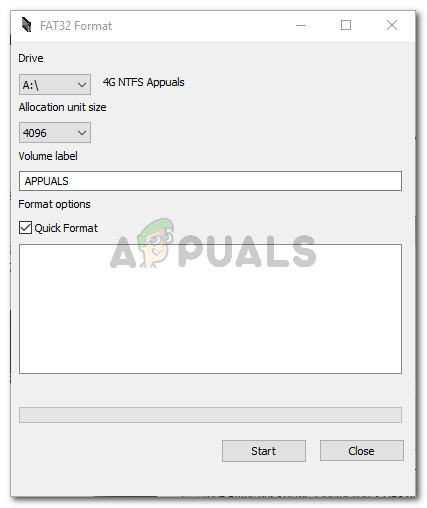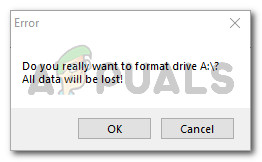What is causing the Virtual Disk Service error: The volume size is too big error?
This particular error is known to occur whenever the user tries to format a large partition or USB hard drive to FAT32. If you try to do it from the Windows interface, you will only get the option to format with the NTFS or exFAT file systems. This happens because Windows cannot format or create a FAT32 volume that is greater than 32GB from Windows (at least not with the Diskpart utility). However, you can mount and use a bigger one without issues. There are several reasons why you’d want to format a drive to the FAT32 file system. Most people do it because they either want to transfer files from a Mac computer or for a console (PS3, Xbox 360, etc.) Fortunately, there are ways to circumvent this Windows shortcoming. If you’re struggling to resolve this particular issue, this article will provide you with several troubleshooting methods. Follow the steps below to bypass the Virtual Disk Service error: The volume size is too big error.
Method 1: Format with DiskPart using the NTFS file system
If you don’t necessarily need to format your drive with the FAT32 file system, you can use DiskPart to format using the NTFS file system. This will not trigger the same Virtual Disk Service error: The volume size is too big error since windows allow you to format partitions or drives larger than 32 GB using the NTFS file system. Note: If you need to format using the FAT32 file system, move down to the next method below. If you decide to use Diskpart to clean and format a drive using the NTFS file system, follow the steps below: You have now successfully reformated the drive with the NTFS file system without receiving the Virtual Disk Service error: The volume size is too big error. If you need to format the drive with the FAT32 partition, follow Method 2.
Method 2: Using a 3rd party utility
If you absolutely need to format your partition to the FAT32 file system, you have little choice but to use a 3rd party utility program. There are a lot of freeware tools that will allow you to bypass Windows 32 GB limitation. We decided to use Fat32 Format because it’s simple, entirely free and it doesn’t include any adware. But you can also use Rufus, SwissKnife and a bunch of other software to achieve the same end result. If you decide to keep it simple, here’s a quick guide on formatting a drive that is larger than 32GB to the FAT32 file system using Fat32 Format:
How to Fix ‘The Item Can’t be Copied because it is too Large For the Volume’s…What is Hard Disk Buffer Size and Does it Matter?Fix: Make Sure the File is an NTFS Volume and isn’t in a Compressed Folder or…How to Add a Virtual Disk to Hyper-V 2019



